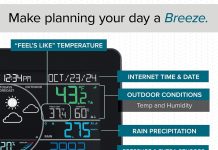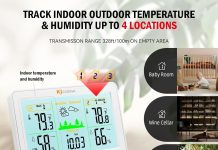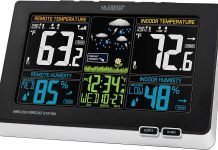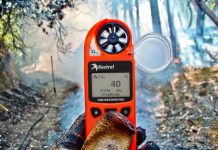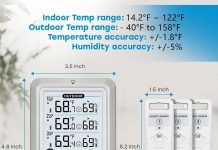Let us take you on a journey through the fascinating world of home weather stations. Ever wondered what goes on behind the scenes to keep these remarkable devices up and running? In this article, we will uncover the essential maintenance tasks required to ensure your home weather station continues to provide accurate and reliable data. From regular cleaning to battery replacements, we will explore the key steps needed to keep your weather station in optimal condition. So, join us as we unravel the secrets of maintaining a home weather station and unlock the wonders of accurate weather forecasting at your fingertips.
Review contents
Checking and Cleaning Sensors
Barometer Sensor
The barometer sensor is a crucial component of a home weather station as it measures atmospheric pressure. Regularly checking and cleaning this sensor is essential to ensure accurate readings. To check the barometer sensor, we need to compare the readings with a trusted source, such as a local weather station or an online resource. If there is a significant difference in the readings, it may indicate a need for calibration or cleaning. Cleaning the barometer sensor involves gently wiping it with a soft cloth to remove any dust or debris that may affect its performance.
Thermometer Sensor
The thermometer sensor is responsible for measuring temperature. To ensure accurate readings, it is essential to periodically check and clean this sensor. Checking the thermometer sensor involves comparing the readings with a reliable reference, such as a digital thermometer or a known temperature source. If there is a noticeable deviation in the readings, it is advisable to recalibrate or clean the sensor. Cleaning the thermometer sensor can be done by gently wiping it with a soft cloth or using a mild cleaning solution if necessary.
Humidity Sensor
The humidity sensor measures the amount of moisture in the air. Regular maintenance of this sensor is crucial for accurate humidity readings. To check the humidity sensor, we can compare its readings with a separate hygrometer or a trusted weather source. If there is a significant discrepancy in the readings, recalibration or cleaning might be necessary. Cleaning the humidity sensor can be done by gently wiping it with a soft cloth or using a mild cleaning solution to remove any dirt or residue that may affect its performance.
Anemometer Sensor
The anemometer sensor measures wind speed and direction. It is essential to regularly check and clean this sensor to ensure accurate wind readings. To check the anemometer sensor, we can compare its readings with a reliable wind measurement device, such as a handheld anemometer. If the readings differ significantly, recalibration or cleaning may be required. Cleaning the anemometer sensor involves removing any debris, such as leaves or insects, from the rotating cups or propeller to prevent any obstruction that could affect its accuracy.
Calibrating the Sensors
Calibrating the sensors in a home weather station is necessary to maintain accurate measurements. Calibration ensures that the sensors are accurately calibrated to the standard values for each weather parameter. It is recommended to calibrate the sensors periodically or whenever there are noticeable discrepancies in the readings. Calibration can be done using calibration kits or by following the manufacturer’s instructions. By calibrating the sensors, we can ensure that the weather station provides reliable and precise data.
Battery Maintenance
Replacing Batteries
Consistent battery maintenance is essential for uninterrupted operation of a home weather station. When the batteries in the weather station become weak or depleted, it can result in inaccurate readings or even a complete shutdown. Regularly monitoring the battery levels and replacing them as needed is vital. It is advisable to use high-quality batteries to ensure prolonged performance. When replacing the batteries, it is important to follow the manufacturer’s instructions and handle them properly.
Monitoring Battery Levels
Monitoring battery levels is critical to prevent unexpected power failures. Most modern weather stations have battery level indicators that display the current battery status. Regularly checking these indicators and keeping track of the battery performance helps in identifying when the batteries need replacement. Additionally, it is recommended to have spare batteries on hand to ensure uninterrupted operation, especially during severe weather events or power outages.
Software Updates
Checking for Firmware Updates
Regularly checking for firmware updates is necessary to keep the weather station’s software up to date. Firmware updates often include bug fixes and performance improvements that enhance the overall functionality of the weather station. To check for firmware updates, visit the manufacturer’s website or refer to the user manual for instructions specific to the model. Staying up to date with the latest firmware ensures optimal performance and accurate data reporting.
Installing Updates
Once firmware updates are available, it is important to install them promptly. Follow the manufacturer’s instructions to successfully install the updates. Before initiating the update process, ensure that the weather station is connected to a stable power source and has sufficient battery backup if applicable. Installing firmware updates helps in resolving any known issues and ensures the weather station’s software stays current with technological advancements.
Protective Measures
Weatherproof Housing
Protecting the weather station from external elements is crucial for maintaining its longevity and accuracy. Investing in a weatherproof housing can shield the equipment from rain, snow, dust, and other environmental factors. A weatherproof housing provides an added layer of protection to the sensors, display units, and other components, preventing water damage or accumulation of dirt. It is important to choose a sturdy and properly sized weatherproof housing designed specifically for the weather station model.
UV Protection
Extended exposure to direct sunlight can cause deterioration of the weather station components, leading to inaccurate readings and reduced lifespan. To protect the weather station from harmful UV rays, it is advisable to install UV protective covers or shields. These covers act as a barrier, minimizing the impact of UV rays on the sensors, display unit, and other sensitive parts. Regularly inspect the UV protection covers for any signs of wear and tear, and replace them if necessary.
Lightning Protection
During thunderstorms, the risk of lightning strikes can pose a significant threat to the weather station. Implementing lightning protection measures, such as installing lightning rods or surge protectors, can help safeguard the equipment from lightning-induced damage. Lightning protection systems divert the electrical charge from lightning strikes away from the weather station, reducing the risk of direct impact. Consult with a professional electrician or weather station specialist for proper installation and to ensure adequate lightning protection.
Data Backup and Storage
Backing up Data
Regularly backing up the data recorded by the weather station is crucial to prevent data loss in case of equipment failure or accidental damage. Many weather station models offer built-in data backup functionality, allowing users to save the recorded data onto external storage devices such as USB drives or memory cards. It is important to follow the manufacturer’s instructions to enable and schedule regular data backups. Additionally, storing the data on cloud-based platforms or external hard drives provides an extra layer of protection against physical damage or theft.
Storing Data
Proper storage of weather station data is essential for easy access and analysis. Organize the data in a systematic manner, categorizing it by date, time, and weather parameters. Consider using spreadsheet software or dedicated weather station software to manage and analyze the collected data effectively. Storing the data in a secure and climate-controlled environment helps maintain its integrity and extends its lifespan. Additionally, regularly cleaning the storage devices and protecting them from physical damage ensures the longevity of the data records.
Regular Inspections
Visual Inspection
Performing regular visual inspections of the weather station helps identify any visible issues or signs of wear and tear. Inspect all components, cables, and connections, looking for loose connections, corrosion, or physical damage. Check for any accumulation of debris or dirt that may obstruct the sensors or affect the performance of the weather station. By conducting visual inspections, we can address any potential problems proactively and ensure the proper functioning of the equipment.
Cable Connections
Proper cable connections are essential for reliable data transmission and accurate readings. Regularly inspect all cable connections in the weather station, ensuring they are secure and free from corrosion or damage. Check for any signs of fraying or exposed wires that might compromise the data integrity. It is advisable to use cable clips or ties to organize the cables and prevent tangling or strain. By maintaining proper cable connections, we can minimize the risk of data loss or distortion.
Mounting Stability
The stability of the weather station’s mounting is crucial to prevent inaccurate readings caused by movement or vibrations. Periodically check the stability and integrity of the mounting system, whether it is a pole, tripod, or any other type of mount. Ensure that the mount is anchored securely and properly aligned. Be mindful of any changes in the mounting structure due to weather conditions or aging, and make necessary adjustments or repairs as needed. By maintaining a stable mounting, we can enhance the accuracy and reliability of the weather station.
Cleaning and Maintenance of Equipment
Case Cleaning
Regularly cleaning the weather station’s case or enclosure is essential to keep the equipment in optimal condition. Use a soft cloth or sponge to gently wipe the case, removing any dust, dirt, or grime that may accumulate over time. Avoid using harsh cleaning agents or abrasive materials that could damage the case’s surface or the weather station’s components. By keeping the case clean, we not only maintain the aesthetic appearance of the equipment but also ensure its longevity.
Sensor Cleaning
Cleaning the sensors themselves is vital for accurate readings. Follow the manufacturer’s instructions for cleaning specific sensor types. In general, gentle wiping with a soft cloth or using a mild cleaning solution is suitable for most sensors. Be cautious not to touch or damage the sensor elements during the cleaning process. Regular sensor cleaning removes any accumulated dirt, debris, or residue, preventing any interference with the data collected. Ensuring clean sensors helps guarantee the accuracy and reliability of the weather station’s measurements.
Cleaning Display Unit
The display unit is the interface through which users interact with the weather station. Keeping it clean is crucial for clear visibility and ease of use. Use a soft, lint-free cloth to wipe the display unit’s screen, removing any fingerprints, dust, or smudges that might obstruct the readability. Avoid using liquid cleaners directly on the screen to prevent damage. If necessary, lightly dampen the cloth with a mild cleaning solution suitable for electronic screens. By regularly cleaning the display unit, we can ensure easy access to the recorded data and improved user experience.
Training and Education
Operator Training
Proper training of the weather station operators is essential to maximize the functionality of the equipment and interpret the collected data accurately. Familiarize the operators with the basic operation of the weather station, including sensor maintenance, data retrieval, and error troubleshooting. Provide comprehensive training on calibrating the sensors, updating the software, and ensuring accurate data interpretation. Regular training sessions, updates, and refreshers help operators maintain their skills and knowledge, ensuring the weather station is utilized effectively.
Understanding Weather Patterns
Having a basic understanding of weather patterns and meteorological concepts is beneficial for operating a home weather station. Educate the operators about weather phenomena such as frontal systems, high and low-pressure systems, and their influence on temperature, humidity, and wind patterns. Understanding the local climate and meteorological conditions helps in interpreting the weather station’s data accurately and provides valuable insights into the prevailing weather patterns. Encourage operators to explore meteorological resources and participate in relevant training programs or online courses to deepen their understanding.
Professional Service
Periodic Check-up
Engaging professional services for periodic check-ups is recommended to ensure the weather station’s optimal performance. Professional technicians possess the expertise to conduct in-depth inspections, perform sensor calibrations, and address any underlying issues. A periodic check-up may include thorough sensor cleaning, testing for accuracy, analyzing data discrepancies, and fine-tuning the weather station’s settings. By partnering with professionals, we can maintain the weather station at its peak performance and detect potential problems before they escalate.
Repair and Maintenance
In case of equipment malfunction or significant issues, professional repair and maintenance services should be sought. Attempting to fix complex problems without sufficient knowledge and experience can lead to further damage or inaccurate readings. Certified technicians specialize in repairing and maintaining weather station components, ensuring they comply with industry standards and specifications. Regularly scheduling professional maintenance and repair services enhances the lifespan of the weather station and guarantees accurate and reliable data reporting.
In conclusion, regular maintenance and careful attention to various aspects of a home weather station are essential to ensure accurate and reliable data collection. By checking and cleaning the sensors, calibrating the equipment, monitoring battery levels, installing software updates, implementing protective measures, and conducting regular inspections, we can maintain the weather station’s functionality and enhance its longevity. Cleaning and maintaining the equipment, providing training and education to the operators, and seeking professional services when needed further contribute to the smooth operation of a home weather station. With proper maintenance and care, our home weather station can continue to provide us with valuable weather information for years to come.


